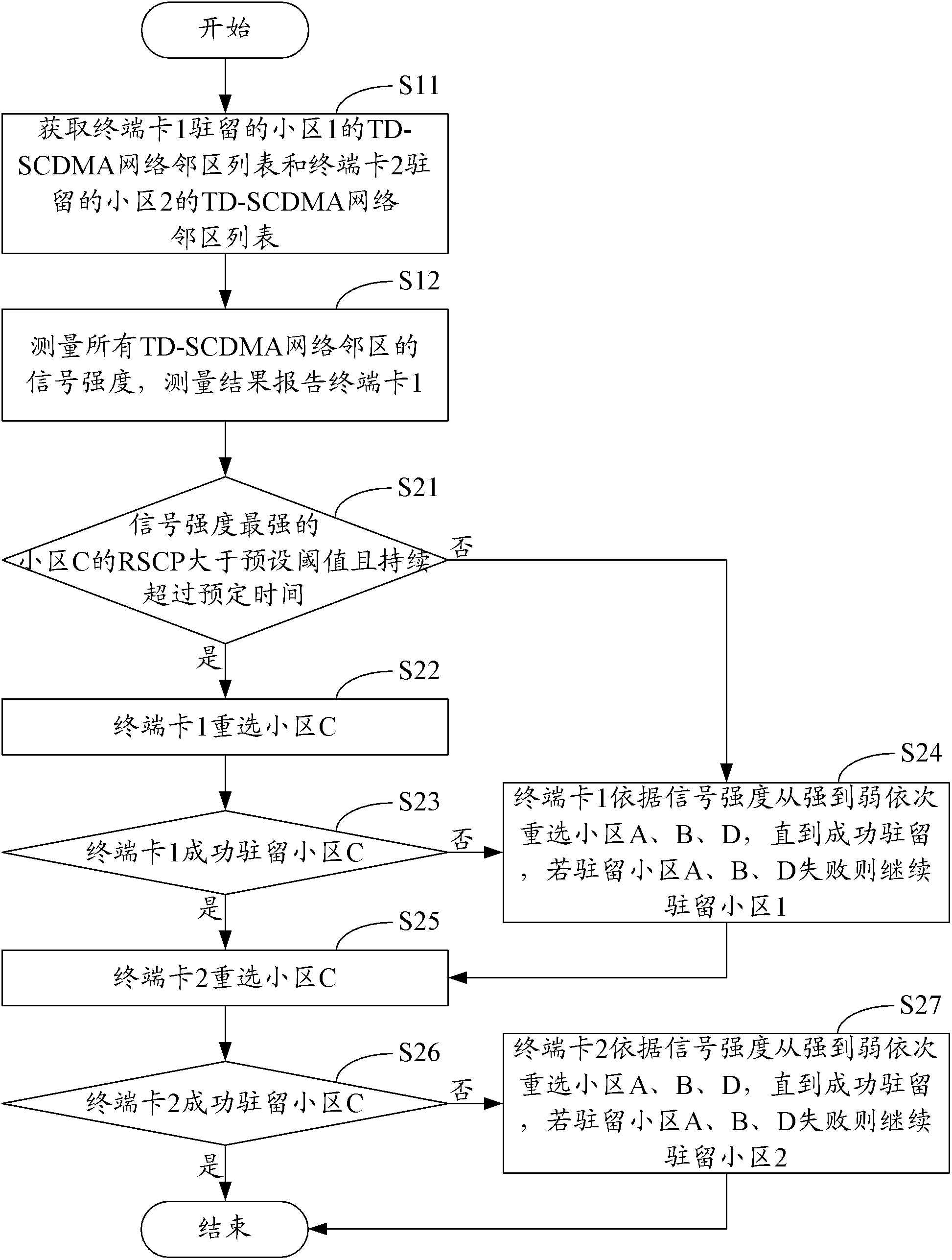Multi-card multimode terminal as well as Inter-RAT cell reselection method and device
A cell reselection, multi-card and multi-mode technology, applied in advanced technologies, electrical components, sustainable buildings, etc., can solve the problems of low cell reselection efficiency and high terminal power consumption in different systems, and achieve reselection and residence time. Shorten, improve reselection efficiency, and reduce the effect of reselection conflict
- Summary
- Abstract
- Description
- Claims
- Application Information
AI Technical Summary
Problems solved by technology
Method used
Image
Examples
Embodiment 1
[0036] The following takes a dual-card dual-mode mobile phone as an example to describe in detail. In this embodiment, the first network is a GSM network, and the second network is a TD-SCDMA network.
[0037] The terminal card 1 of the dual-card dual-mode mobile phone currently resides in cell 1 (GSM network cell), and the terminal card 2 currently resides in cell 2 (GSM network cell). When terminal card 1 complies with the protocol (3GPP TS 45.008 protocol) When the cell reselection condition of the different system is met, the terminal card 1 and the terminal card 2 are triggered to perform the reselection of the adjacent cell of the different system (TD-SCDMA network adjacent cell), wherein the terminal card 1 is set as the master card.
[0038] First, measure the signal strength of the TD-SCDMA network adjacent cell of cell 1 and the TD-SCDMA network adjacent cell of cell 2 (corresponding figure 1 Step S1).
[0039] Specifically, please refer to figure 2 , execute step...
Embodiment 2
[0055] In this embodiment, the first network is a TD-SCDMA network, and the second network is a GSM network.
[0056] The terminal card 1 of the dual-card dual-mode mobile phone currently resides in cell A (TD-SCDMA network cell), and the terminal card 2 currently resides in cell C (TD-SCDMA network cell). When the terminal card 2 conforms to the protocol (3GPP TS25. 304) When the specified conditions for cell reselection of different systems are triggered, terminal card 2 and terminal card 1 are triggered to perform reselection of neighboring cells of different systems (GSM network neighboring cells), wherein terminal card 2 is set as the main card.
[0057] First, measure the signal strength of the GSM network neighbors of cell A and the GSM network neighbors of cell C (corresponding figure 1 Step S1).
[0058] Specifically, please refer to image 3 , execute step S31, obtain the GSM network neighbor list of the TD-SCDMA network cell where each terminal card resides, that ...
Embodiment 3
[0082] Terminal card 1 of the four-card dual-mode mobile phone currently resides in cell 1 (GSM network cell), terminal card 2 currently resides in cell 2 (GSM network cell), and terminal card 3 currently resides in cell A (TD-SCDMA network cell). cell), the terminal card 4 currently resides in cell C (TD-SCDMA network cell).
[0083] When terminal card 1 meets the conditions for different-system cell reselection stipulated in the protocol, terminal card 1 and terminal card 2 are triggered to perform reselection of different-system adjacent cells (TD-SCDMA network adjacent cells), while terminal card 3 continues to reside in cell A , the terminal card 4 continues to reside in cell C.
[0084] Among them, the process of terminal card 1 and terminal card 2 performing TD-SCDMA network neighbor reselection can refer to figure 2 , terminal card 1 is the main card.
PUM
 Login to View More
Login to View More Abstract
Description
Claims
Application Information
 Login to View More
Login to View More - R&D
- Intellectual Property
- Life Sciences
- Materials
- Tech Scout
- Unparalleled Data Quality
- Higher Quality Content
- 60% Fewer Hallucinations
Browse by: Latest US Patents, China's latest patents, Technical Efficacy Thesaurus, Application Domain, Technology Topic, Popular Technical Reports.
© 2025 PatSnap. All rights reserved.Legal|Privacy policy|Modern Slavery Act Transparency Statement|Sitemap|About US| Contact US: help@patsnap.com



